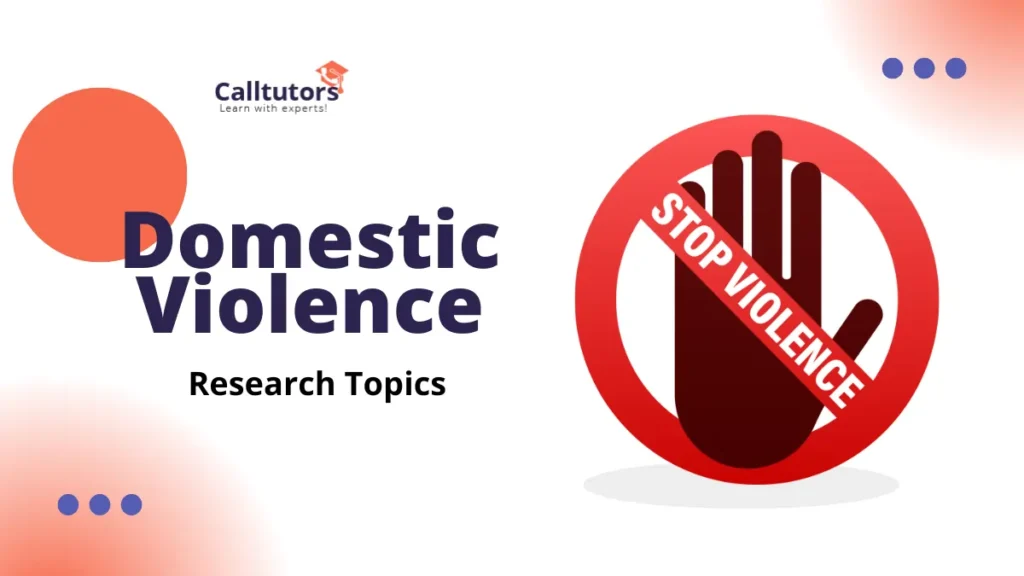Domestic violence is a big problem worldwide, affecting many people, families, and communities. Researchers have made progress in understanding why it happens and how to stop it.
This article lists over 161 possible research topics about domestic violence. It covers things like what domestic violence is, why it happens, how it affects different cultures, its effects on victims, ways to help abusers, laws about it, and more.
Whether you’re an activist, counselor, lawmaker, or scholar, researching domestic violence can help make society better at dealing with it.
The list of topics also shows where there’s still more to learn. Scientists, professionals, and students in fields like psychology, social work, criminology, and medicine might find these gaps interesting to explore further.
Recommended Readings: Top 121+ French Revolution Research Topics – Full Guide!
Some Prevalence And Statistics Related To Domestic Violence!
Table of Contents
According to a World Health Organization (WHO) report, nearly one in every three women from all over the world are likely to have experienced either physical or sexual violence by a partner or sexual violence by someone else who is not their partner throughout their life.
Some key easy-to-understand facts about how often domestic violence happens include:
- Over 10 million people face domestic violence in America each year. Nationwide Coalition Against Domestic Violence says almost 20 persons are physically assaulted by an intimate partner per minute.
- One out of four women and one in nine men encounter serious physical abuse, sexual assault, or stalking perpetrated by their loved ones, and this leads to things like injury, fear, PTSD, use of victim services, and contracting STDs, among others.
- On average, national hotlines for domestic violence receive over twenty thousand calls each day. If there is any presence of guns during any such occurrences, then the risk for homicide becomes five times higher than it was before.
- 15% of all violent crimes in the USA can be attributed to intimate partner violence. Almost 80% of victims who ever experienced that type of crime from an intimate partner are females.
- Domestic violence does not discriminate according to age, race, ethnicity, social class, or level of education. Still, women between the ages of eighteen and twenty-four are predominantly exposed to higher instances of domestic violence.
These simple statistics show how much domestic violence occurs in our local communities and the nation at large.
A basic understanding of this matter is needed to challenge the problem with supportive services for victims and their families, education aimed at prevention, and policy changes that help give more power to victims and law enforcement agencies.
Top 161+ Domestic Violence Research Topics
Here is our list of over 161 domestic violence research topics; please look.
Risk Factors
- Role of childhood trauma in perpetuating domestic violence
- Substance abuse and its association with domestic violence
- Psychological factors contributing to domestic violence perpetration
- Impact of cultural norms on attitudes toward domestic violence
Effects on Victims
- Long-term psychological effects of domestic violence on survivors
- Physical health consequences of domestic violence
- Economic impact of domestic violence on survivors
- Intergenerational transmission of trauma in families affected by domestic violence
Effects on Children
- Effects of witnessing domestic violence on children’s mental health
- Academic performance of children from households affected by domestic violence
- Intervention strategies to mitigate the impact of domestic violence on children
- Long-term outcomes for children exposed to domestic violence
Prevention and Intervention
- Efficacy of prevention programs in reducing domestic violence rates
- Role of bystander intervention in preventing domestic violence
- Effectiveness of legal measures (restraining orders, etc.) in protecting victims
- Innovative technology-based interventions for domestic violence prevention
Legal and Policy Perspectives
- Analysis of domestic violence legislation across different jurisdictions
- Evaluation of law enforcement responses to domestic violence calls
- Role of family court systems in addressing domestic violence cases
- Impact of immigration policies on immigrant survivors of domestic violence
Sociocultural Factors
- Intersectionality and its role in understanding domestic violence experiences
- Cultural norms surrounding masculinity and their impact on domestic violence
- Influence of media portrayals on perceptions of domestic violence
- Role of religion and spirituality in shaping responses to domestic violence
Perpetrator Characteristics
- Profiles of domestic violence perpetrators
- Psychological profiles of serial domestic violence offenders
- Impact of childhood experiences on later perpetration of domestic violence
- Relationship dynamics contributing to the perpetration of domestic violence
Trauma-Informed Approaches
- Trauma-informed care for domestic violence survivors
- Incorporating trauma-informed principles into law enforcement responses
- Role of Healthcare Providers in recognizing and Addressing domestic violence trauma
- Trauma recovery strategies for survivors of domestic violence
Technology and Domestic Violence
- Cyberstalking and digital forms of domestic violence
- Use of technology in domestic violence prevention and intervention efforts
- Impact of social media on domestic violence disclosure and support-seeking
- Ethical considerations in utilizing technology to address domestic violence
Marginalized Communities
- Domestic violence within LGBTQ+ communities
- Intersectional experiences of domestic violence among minority women
- Barriers to accessing support services for marginalized survivors
- Culturally competent interventions for domestic violence in immigrant communities
Economic Perspectives
- Economic empowerment programs for domestic violence survivors
- Impact of financial abuse on survivors’ economic autonomy
- Housing instability among survivors of domestic violence
- Employer responses to employees experiencing domestic violence
Rural and Urban Dynamics
- Unique challenges faced by rural survivors of domestic violence
- Access to services for urban survivors of domestic violence
- Law enforcement response disparities in rural vs. urban areas
- Community-based approaches to domestic violence prevention in rural settings
Mental Health Considerations
- Occurrence of domestic violence and mental health disorders at the same time.
- Trauma-informed approaches to mental health treatment for survivors
- Impact of domestic violence on survivors’ self-esteem and self-efficacy
- Therapeutic stepping-in for survivors coping with PTSD from domestic violence
Child Welfare System
- The intersection of domestic violence and child welfare interventions
- Challenges in identifying and addressing domestic violence in child welfare cases
- Impact of domestic violence on child custody and visitation decisions
- Collaborative approaches between domestic violence advocates and child welfare agencies
Global Perspectives
- Cross-cultural variations in perceptions and responses to domestic violence
- Effectiveness of international treaties and agreements in addressing domestic violence
- Human rights implications of domestic violence legislation worldwide
- Innovative approaches to addressing domestic violence in developing countries
Impact of COVID-19 Pandemic
- Impact of lockdown measures on domestic violence rates
- Effectiveness of remote support services for survivors during the pandemic
- Challenges faced by frontline workers in responding to domestic violence during the pandemic
- Long-term implications of the pandemic on domestic violence prevention efforts
Elder Abuse and Domestic Violence
- Intersection of elder abuse and domestic violence in caregiving relationships
- Challenges in identifying and addressing elder maltreatment within domestic violence contexts
- Support services tailored to older survivors of domestic violence
- Legal and policy responses to elder abuse within domestic violence cases
Military and Veterans
- Prevalence of domestic violence within military and veteran communities
- Unique challenges faced by military families affected by domestic violence
- Effectiveness of military support systems in addressing domestic violence
- Trauma recovery resources for veterans experiencing domestic violence
Community-Based Interventions
- Role of community-based organizations in domestic violence prevention
- Collaborative approaches between law enforcement and community organizations
- Culturally specific support services offered by community groups
- Grassroots initiatives to raise awareness and prevent domestic violence
Impact on Healthcare Systems
- Healthcare costs associated with domestic violence-related injuries
- Screening Protocols for identifying domestic violence in healthcare settings
- Role of healthcare providers in documenting and reporting domestic violence cases
- Integration of domestic violence services into healthcare systems
Restorative Justice Approaches
- Restorative justice models for addressing domestic violence
- Victim-offender mediation in domestic violence cases
- Challenges and benefits of implementing restorative justice in domestic violence contexts
- Role of community support in restorative justice processes
Role of Education
- Incorporating domestic violence education into school curricula
- Effectiveness of educational programs in preventing teen dating violence
- Educating healthcare providers on recognizing and responding to domestic violence
- Role of universities in training future professionals to address domestic violence
Family Dynamics and Interventions
- Impact of domestic violence on family relationships and dynamics
- Family therapy approaches for addressing domestic violence
- Coordinated community responses to support families affected by domestic violence
- Role of extended family networks in supporting survivors and holding perpetrators accountable
Substance Abuse and Domestic Violence
- Co-occurrence of substance abuse and domestic violence
- Integrated treatment approaches for survivors dealing with substance abuse and domestic violence
- Impact of substance abuse on perpetrators’ accountability for domestic violence
- Support services tailored to survivors navigating recovery from substance abuse and domestic violence
Criminal Justice System Responses
- Effectiveness of diversion programs for domestic violence offenders
- Challenges in prosecuting domestic violence cases without survivor cooperation
- Court-mandated interventions for domestic violence perpetrators
- Sentencing disparities in domestic violence cases based on race, gender, and socioeconomic status
LGBTQ+ Intimate Partner Violence
- Unique dynamics of intimate partner violence within LGBTQ+ relationships
- Barriers to accessing support services for LGBTQ+ survivors of domestic violence
- Role of LGBTQ+ community organizations in addressing intimate partner violence
- Legal and policy considerations in addressing LGBTQ+ intimate partner violence
Community Policing and Domestic Violence
- Implementing community policing models to address domestic violence
- Collaborative approaches between police departments and community organizations
- Training law enforcement officers in trauma-informed responses to domestic violence
- Building trust between marginalized communities and law enforcement in domestic violence cases
Human Trafficking and Domestic Violence
- Intersection of human trafficking and domestic violence
- Identifying and supporting survivors of domestic violence who are also victims of human trafficking
- Legal and policy responses to addressing human trafficking within domestic violence contexts
- Collaborative efforts between anti-trafficking organizations and domestic violence service providers
Technology-Facilitated Abuse
- Types and prevalence of technology-facilitated abuse in domestic violence cases
- Impact of technology-facilitated abuse on survivors’ safety and well-being
- Legal and policy responses to addressing technology-facilitated abuse
- Role of tech companies in preventing and responding to technology-facilitated abuse
Mental Health Services for Survivors
- Accessibility of mental health services for survivors of domestic violence
- Trauma-informed approaches in mental health treatment for survivors
- Integrating peer support networks into mental health services for survivors
- Addressing stigma and barriers to seeking mental health support among survivors
LGBTQ+ Youth and Domestic Violence
- Prevalence and experiences of domestic violence among LGBTQ+ youth
- Barriers to accessing support services for LGBTQ+ youth experiencing domestic violence
- Role of schools and youth-serving organizations in addressing LGBTQ+ youth domestic violence
- Legal and policy considerations in protecting LGBTQ+ youth from domestic violence
Restorative Justice in Indigenous Communities
- Indigenous perspectives on restorative justice in addressing domestic violence
- Traditional healing approaches for survivors and perpetrators within Indigenous communities
- Collaborative efforts between Indigenous communities and mainstream justice systems
- Challenges and successes of incorporating restorative justice in Indigenous domestic violence cases
Domestic Violence in Disabilities Communities
- Prevalence and experiences of domestic violence among individuals with disabilities
- Barriers to accessing support services for individuals with disabilities experiencing domestic violence
- Intersectionality of disability and domestic violence in legal and policy responses
- Role of disability advocates and service providers in addressing domestic violence
Financial Literacy and Economic Empowerment
- Role of financial literacy programs in empowering survivors of domestic violence
- The economic impact of domestic violence on survivors’ financial stability
- Employment opportunities and challenges for survivors rebuilding after domestic violence
- Collaborations between financial institutions and domestic violence service providers
Technology-Based Intervention Programs
- Efficacy of technology-based intervention programs in reducing domestic violence
- Accessibility and user engagement in technology-based intervention platforms
- Privacy and security considerations in technology-based intervention programs
- Tailoring technology-based interventions to diverse populations and cultural contexts
Domestic Violence in Aging Populations
- Prevalence and unique challenges of domestic violence among older adults
- Barriers to identifying and addressing domestic violence in aging populations
- Support services and interventions tailored to older survivors of domestic violence
- Legal and policy responses to domestic violence in aging populations
International Approaches to Prevention
- Comparative analysis of domestic violence prevention strategies across different countries
- Role of international organizations in promoting global efforts to address domestic violence
- Cultural adaptations of evidence-based prevention programs in international contexts
- Challenges and successes of implementing prevention strategies in diverse cultural settings
Domestic Violence and Homelessness
- Intersection of domestic violence and homelessness
- Barriers to housing and support services for survivors of domestic violence
- Trauma-informed approaches to addressing domestic violence within homeless populations
- Collaborative efforts between domestic violence service providers and homeless shelters
Immigration and Domestic Violence
- Immigration status as a barrier to seeking help for survivors of domestic violence
- Legal protections and pathways to residency for immigrant survivors of domestic violence
- Culturally competent support services for immigrant survivors navigating legal processes
- Intersectional experiences of immigrant survivors of domestic violence
Advocacy and Policy Change
- Role of grassroots advocacy in shaping domestic violence policy
- Policy recommendations to improve responses to domestic violence within marginalized communities
- Collaborative efforts between advocacy organizations and policymakers to address domestic violence
- Impact of survivor-led Movements on Shaping Domestic Violence Legislation and Policy
Impact of Domestic Violence on Pets
- Intersection of domestic violence and animal abuse
- Barriers to seeking help for survivors with pets in domestic violence situations
- Role of animal shelters and Advocacy organizations in Supporting Survivors of Pets
- Legal and policy responses to protecting pets in domestic violence cases
Here are some crucial domestic violence topics, which are divided according to different categories. This will help you address the domestic violence matter and understand it completely.
Domestic Violence’s Legal And Policies Framework!
Family violence, also called violence between partners, used to be seen as a private family problem. But in recent decades, new laws and plans have been made to see family violence as a public problem that needs help. Key statutes and plans about family violence include:
- The Violence Against Women Act-(VAWA) – Was the first significant federal law passed in 1994 to assist victims of family violence. The enactment provides money and support for inquiries and trials concerning violent offenses against females.
- State family violence laws – All 50 U.S. states have laws making family violence illegal and allowing for protection orders. Laws vary by state but often require arrest for family violence, calls to the police, and increased penalties.
- Workplace rules – Federal and state laws requiring workplace protections, leave time, and anti-discrimination policies for family violence victims have increased over the past 25 years.
- Community-wide response – Many communities have adopted coordinated systems to improve teamwork between police, courts, advocacy groups, and health providers to respond to family violence.
- International laws and agreements – Globally, family violence is now widely recognized as a human rights issue, with some countries making major national laws as a result.
While structures still have problems and more progress is needed, how society views family violence has greatly changed from a private issue to unacceptable harm to society, needing solutions through laws and plans.
Wrap Up
Domestic violence is a serious problem that hurts people, families, and communities all around the world. Even though more people know about it now and laws to protect against it have gotten better, there’s still a lot of work to do.
Doctors, psychologists, sociologists, lawyers, and advocates all need to keep working together to really solve the problem of violence in families and between partners.
This blog post talks about different research topics that show how complicated domestic violence is and how many different ideas there are for fixing it.
If we keep getting better at researching, educating people, changing laws, and giving money to help, we can hope for a future where no one has to suffer from family violence.
But there are still things we don’t understand well, like how to tell when someone might be in danger, what things make violence more likely, how different cultures affect it, what the best ways to stop it are, and how society should respond.
I hope this blog of research topics can help with all of those efforts.
FAQs
What are some common misconceptions about domestic violence?
Common misconceptions are that it only happens to certain people, victims provoke it, and abusers can’t control themselves.
How does domestic violence impact children and families?
Domestic violence negatively impacts children’s development and family relationships. There is an increased risk of mental health issues.
What role do societal attitudes play in perpetuating domestic violence?
Societal attitudes that treat domestic violence as taboo or acceptable allow it to continue. Victim blaming also perpetuates the problem.
Are there cultural differences in how domestic violence is perceived and addressed?
Cultural differences in gender roles, privacy views, and reporting acceptance impact how domestic violence is perceived and handled.
What steps can individuals take to support victims of domestic violence in their communities? Please give me short answers to all of these questions
Individuals can support victims by believing in and empowering them, connecting them with resources, and advocating to elected officials for improved legal protections.



